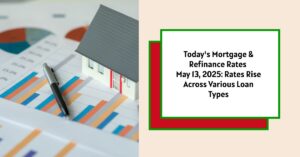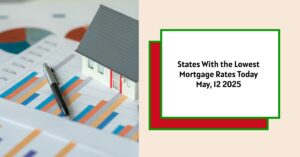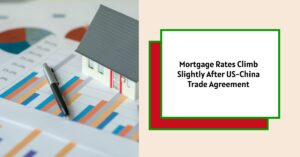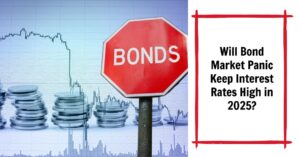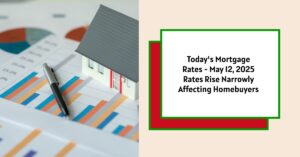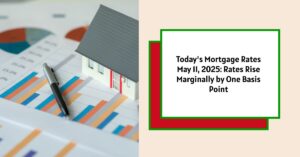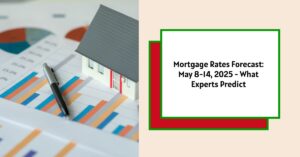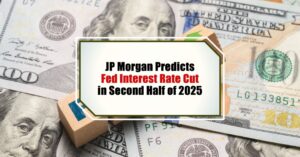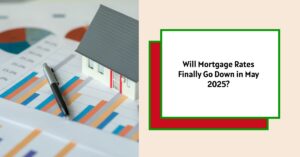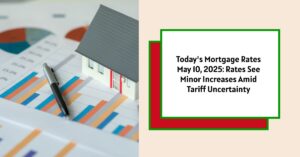As of May 13, 2025, mortgage rates have increased to approximately 6.80%, a slight rise primarily linked to a recent trade agreement between the United States and China which has temporarily paused heightened tariffs on goods traded between the two countries. This trade development comes amid a backdrop of rising investor concerns, leading to the conclusion that while recession fears may reduce, mortgage rates may not necessarily follow suit and drop. Instead, the prevailing sentiment seems to indicate a stabilization or slight increase in rates moving forward.
Today's Mortgage & Refinance Rates – May 13, 2025: Rates Rise Across Various Loan Types
Key Takeaways:
- Current Average Mortgage Rate: 6.80%
- Rates Increased: Due to trade tensions easing and heightened economic uncertainty.
- Refinance Rates: Show a similar upward trend across various mortgage types.
- Economic Influences: Tariff decisions and Federal Reserve policies significantly impact rates.
- Market Outlook: The future of mortgage rates remains uncertain as policymakers continue to evaluate inflation and economic growth prospects.
In today's financial landscape, staying current with mortgage rates and understanding their trends is essential for anyone looking to purchase a home or refinance their existing mortgage. The mortgage market is where buyers and homeowners decide how they will finance their properties, and every percentage point in mortgage rates can significantly impact monthly payments and overall affordability.
What Are Today's Mortgage Rates?
According to data from Zillow, the average mortgage rates for May 13, 2025, are as follows:
| Mortgage Type | Average Rate Today |
|---|---|
| 30-Year Fixed | 6.79% |
| 20-Year Fixed | 6.52% |
| 15-Year Fixed | 6.07% |
| 7/1 Adjustable Rate | 7.56% |
| 5/1 Adjustable Rate | 7.62% |
| 30-Year FHA | 5.95% |
| 30-Year VA | 6.36% |
The 30-Year Fixed Rate Mortgage continues to be the favorite among borrowers, primarily because of its long-term stability and predictability. Borrowers choose this option to ensure that their monthly payment remains fixed for the entire life of the loan. While the 30-year fixed mortgage offers manageable monthly payments over time, the longer duration means more interest paid over the life of the loan compared to shorter terms, such as the 15-Year Fixed Rate mortgage.
15-Year Fixed Rate Mortgages have become an appealing choice for those who want to minimize total interest costs. The current average for a 15-year fixed mortgage is around 6.07%. While monthly payments will be higher than those of a 30-year mortgage, the advantage lies in paying off the loan faster and saving significantly on interest over time.
Current Mortgage Refinance Rates
Homeowners looking to refinance are finding themselves in an environment where the rates for refinancing have not been favorable recently either. Here’s the latest average refinancing data from Zillow:
| Refinance Mortgage Type | Average Rate Today |
|---|---|
| 30-Year Fixed Refinance | 6.84% |
| 20-Year Fixed Refinance | 6.46% |
| 15-Year Fixed Refinance | 6.09% |
| 7/1 ARM Refinance | 7.67% |
| 5/1 ARM Refinance | 7.82% |
| 30-Year FHA Refinance | 5.75% |
| 30-Year VA Refinance | 6.25% |
Refinancing can be a strategic move for homeowners looking to lower their monthly payments, consolidate debt, or withdraw cash from their home’s equity. An important consideration when deciding on refinancing is understanding the costs associated with it. Homeowners often debate if they should refinance based on the savings they would achieve through a lower interest rate. The general recommendation often cited by financial advisors is to consider refinancing if you can reduce the existing mortgage rate by at least one percent.
This can be calculated by comparing the new monthly payment to the existing payment, and considering the total costs of refinancing, such as closing costs. If a homeowner pays $3,000 to refinance and reduces their monthly payment by $200, it would take them about 15 months to break even on their refinancing costs.
Understanding Mortgage Rate Fluctuations
Several interlinked factors contribute to the current fluctuations in mortgage rates. Economic trends, market sentiment, and Federal Reserve policies all play critical roles in shaping the mortgage landscape.
- Economic Factors: Economic data that indicates inflation or growth can drive a rise in mortgage rates because lenders will want to offset the risk that future inflation might erode the value of the fixed payments. Reports regarding job growth, consumer spending, and wage inflation can all signal economic strength, which may lead to increased borrowing costs as lenders perceive less risk.
- Federal Reserve Policies: The Federal Reserve (often referred to simply as “the Fed”) influences mortgage rates through its policy decisions regarding the federal funds rate—the interest at which banks lend to each other overnight. Although mortgage rates do not adjust directly in tandem with the federal funds rate, they are influenced by expectations surrounding monetary policy. For instance, a rate hike by the Fed could prompt lenders to raise mortgage rates in anticipation of increased costs for borrowing.
- Investor Sentiment: Mortgage rates are also influenced by investor preferences in the bond market. Mortgage-backed securities (MBS) are bonds composed of various home loans, and when investor interest in these securities declines, lenders might raise mortgage rates to entice investors back into the market with higher yields.
Read More:
Mortgage Rates Trends as of May 12, 2025
Dave Ramsey Predicts Mortgage Rates Will Probably Drop Soon in 2025
Future of Mortgage Rates Post-Fed Decision: Will Rates Drop?
Fed's Decision Signals Mortgage Rates Won't Go Down Significantly
Current Trends in Mortgage Rates and the Economy
As we reflect on mortgage rates’ tendencies over the past few months, we see a pattern of gradual increases. Rates have risen from 6.71% in April, signaling a broader market trend that reflects not just recent tariff negotiations but also ongoing fiscal policies and inflation concerns. The gradual rise of rates is in contrast to the earlier expectations from the beginning of the year, where many experts predicted substantial rate cuts by the Fed for an anticipated recession.
Recent tariff agreements between the U.S. and China, aimed at averting severe economic downturns, provide a valuable context for understanding these rate movements. The agreement to pause heightened tariffs for 90 days has unnerved some investors, primarily due to historical apprehensions surrounding trade policy unpredictability. In essence, while lessening economic uncertainty seems positive, it has contributed to the slight uptick in mortgage rates as markets adjust their expectations.
Will Home Prices Drop in 2025?
A critical component of the housing market amidst rising rates is the ongoing trend in home prices. Despite the anxiety around increasing mortgage costs, home prices are anticipated to maintain a growth pattern. According to industry analysts from Fannie Mae, home prices are expected to increase by 4.1% in 2025. This represents a moderated pace compared to previous years’ explosive growth, reflecting a market striving for balance amid economic constraints.
Challenges like slow inventory growth, high demand, and continued low housing supply fuel this upward pressure. Given that prospective homebuyers grapple with high rates, market dynamics indicate that many will still be willing to purchase homes, leading to continued appreciation in home prices.
Choosing the Right Mortgage Option
For homebuyers navigating this complex landscape, understanding the array of lending options is crucial:
- Fixed-Rate Mortgages: These loans provide consistent monthly payments and are ideal for those seeking financial predictability. By locking in an interest rate, borrowers can shield themselves from possible future hikes. This stability often comes at a slightly higher short-term rate compared to adjustable options but can save borrowers significant amounts in total interest if markets surge.
- Adjustable-Rate Mortgages (ARMs): Initially attractive for their lower starting rates, such loans come with the caveat of fluctuating rates after an introductory period. ARMs may make sense for buyers planning to sell or refinance within a short timeframe, as they can secure lower payments upfront. However, potential future rate increases should weigh heavily in their decision-making process.
- Government-Backed Loans: Options like FHA, VA, and USDA loans can make homeownership accessible to those with lower credit scores or limited down payment capabilities. These loans often come with favorable terms compared to conventional loans, making them a worthwhile consideration for first-time homebuyers.
Conclusion: The Mortgage Market Outlook
Examining today's mortgage rates as of May 13, 2025, reveals a nuanced landscape shaped by trade negotiations, economic factors, and investor sentiment. While the rise in rates poses challenges for potential homebuyers and those considering refinancing, understanding these elements equips consumers with the knowledge to navigate the mortgage process effectively. The interplay of various economic indicators, Federal Reserve policies, and local market conditions create a complex yet manageable scenario for securing home financing in today's environment.
As we continue into 2025, all eyes will be on how these factors evolve, and their cumulative effects on borrowing costs will undoubtedly impact the broader housing market.
Invest Smarter in a High-Rate Environment
With mortgage rates remaining elevated this year, it's more important than ever to focus on cash-flowing investment properties in strong rental markets.
Norada helps investors like you identify turnkey real estate deals that deliver predictable returns—even when borrowing costs are high.
HOT NEW LISTINGS JUST ADDED!
Connect with a Norada investment counselor today (No Obligation):
(800) 611-3060
Also Read:
- Will Mortgage Rates Go Down in 2025: Morgan Stanley's Forecast
- Expect High Mortgage Rates Until 2026: Fannie Mae's 2-Year Forecast
- Mortgage Rate Predictions 2025 from 4 Leading Housing Experts
- Mortgage Rates Forecast for the Next 3 Years: 2025 to 2027
- 30-Year Mortgage Rate Forecast for the Next 5 Years
- 15-Year Mortgage Rate Forecast for the Next 5 Years
- Why Are Mortgage Rates Going Up in 2025: Will Rates Drop?
- Why Are Mortgage Rates So High and Predictions for 2025
- Will Mortgage Rates Ever Be 3% Again in the Future?
- Mortgage Rates Predictions for Next 2 Years
- Mortgage Rate Predictions for Next 5 Years
- Mortgage Rate Predictions: Why 2% and 3% Rates are Out of Reach
- How Lower Mortgage Rates Can Save You Thousands?
- How to Get a Low Mortgage Interest Rate?
- Will Mortgage Rates Ever Be 4% Again?
